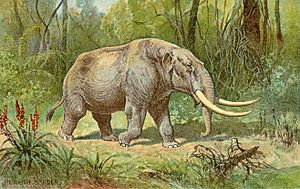Hiscock Site facts for kids
The Hiscock Site is an amazing place in Byron, Western New York, USA. It's important for both archaeology (the study of human history through digging up old things) and paleobiology (the study of ancient life). Scientists have found many things here, like bones from huge, extinct animals called mastodons and tools made by Paleo-Indians (the first people in North America). They've also found plants and animals that weren't known to live in Western New York during the late Pleistocene Ice Age. The Buffalo Museum of Science now owns the site, and experts have been studying it since 1983.
Contents
What is the Hiscock Site?
A Look Back 10,000 Years Ago
About 10,000 years ago, the Hiscock Site was covered by a big lake called Lake Tonawanda. This lake formed from the water that melted off the huge, retreating glaciers that once covered the land. Imagine a giant ice cube melting and creating a lake!
Digging Up History Since 1983
Scientists started digging at the Hiscock Site in 1983. They immediately found some surprising things! Dr. Richard Laub, a curator at the Buffalo Museum of Science, officially told the world about the site in 1986. A few years later, in 1989, the Hiscock family generously gave 10 acres of the site to the Buffalo Museum of Science for research. Since 1983, people have been digging and studying the site every year during certain seasons. More than 200 volunteers from all over the world, along with American researchers and students, have helped uncover its secrets.
Amazing Discoveries
Prehistoric Mastodons
Mastodons were huge, prehistoric animals that are now extinct. They looked a lot like modern elephants, but they were a different type of animal. Mastodons lived in North America for almost 4 million years, starting in the Tertiary period. They finally disappeared about 10,000 years ago. Some mastodons also lived in Europe, but they died out much earlier, about 2 to 3 million years ago.
Mastodon Bones and More
During the digs at the Hiscock Site, many parts of mastodons have been found. These include huge tusks, pieces of tusks, ivory, ankle bones, teeth, parts of skulls, and even pieces of their spines. Over 13 tusks have been discovered at the site! Scientists have studied the tips of these mastodon tusks. They found that the mastodons used their tusks to dig up special clay that was rich in sodium. They did this during a time when there wasn't much water, like a big drought.
Tools from Ancient People
Scientists have also found proof that Paleo-Indians lived at the Hiscock Site. They've discovered flint pieces (left over from making tools), stone tools, and special pointed stones called fluted projectile points. These points were probably attached to sticks or spears for hunting animals like mastodons.



